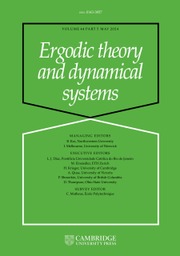Crossref Citations
This article has been cited by the following publications. This list is generated based on data provided by
Crossref.
Baake, Michael
Kösters, Holger
and
Moody, Robert V.
2015.
Diffraction Theory of Point Processes: Systems with Clumping and Repulsion.
Journal of Statistical Physics,
Vol. 159,
Issue. 4,
p.
915.
Baake, Michael
and
Gähler, Franz
2016.
Pair correlations of aperiodic inflation rules via renormalisation: Some interesting examples.
Topology and its Applications,
Vol. 205,
Issue. ,
p.
4.
Baake, Michael
and
Lenz, Daniel
2017.
Spectral notions of aperiodic order.
Discrete & Continuous Dynamical Systems - S,
Vol. 10,
Issue. 2,
p.
161.
LENZ, DANIEL
and
MOODY, ROBERT V.
2017.
Stationary processes and pure point diffraction.
Ergodic Theory and Dynamical Systems,
Vol. 37,
Issue. 8,
p.
2597.
Mañibo, Neil
2017.
Lyapunov exponents for binary substitutions of constant length.
Journal of Mathematical Physics,
Vol. 58,
Issue. 11,
Baake, Michael
Huck, Christian
and
Strungaru, Nicolae
2017.
On weak model sets of extremal density.
Indagationes Mathematicae,
Vol. 28,
Issue. 1,
p.
3.
Baake, Michael
Grimm, Uwe
and
Mañibo, Neil
2018.
Spectral analysis of a family of binary inflation rules.
Letters in Mathematical Physics,
Vol. 108,
Issue. 8,
p.
1783.
BARTLETT, ALAN
2018.
Spectral theory of substitutions.
Ergodic Theory and Dynamical Systems,
Vol. 38,
Issue. 4,
p.
1289.
AUJOGUE, JEAN-BAPTISTE
2020.
Pure point/continuous decomposition of translation-bounded measures and diffraction.
Ergodic Theory and Dynamical Systems,
Vol. 40,
Issue. 2,
p.
309.
Frank, Natalie Priebe
2020.
Substitution and Tiling Dynamics: Introduction to Self-inducing Structures.
Vol. 2273,
Issue. ,
p.
33.
Bufetov, Alexander I.
and
Solomyak, Boris
2020.
A spectral cocycle for substitution systems and translation flows.
Journal d'Analyse Mathématique,
Vol. 141,
Issue. 1,
p.
165.
Lenz, D.
2020.
Spectral theory of dynamical systems as diffraction theory of sampling functions.
Monatshefte für Mathematik,
Vol. 192,
Issue. 3,
p.
625.
Akkermans, Eric
Don, Yaroslav
Rosenberg, Jonathan
and
Schochet, Claude L.
2021.
Relating diffraction and spectral data of aperiodic tilings: Towards a Bloch theorem.
Journal of Geometry and Physics,
Vol. 165,
Issue. ,
p.
104217.
Frank, Natalie Priebe
and
Mañibo, Neil
2022.
Spectral theory of spin substitutions.
Discrete and Continuous Dynamical Systems,
Vol. 42,
Issue. 11,
p.
5399.
Mañibo, Neil
Rust, Dan
and
Walton, James J.
2023.
Spectral properties of substitutions on compact alphabets.
Bulletin of the London Mathematical Society,
Vol. 55,
Issue. 5,
p.
2425.

